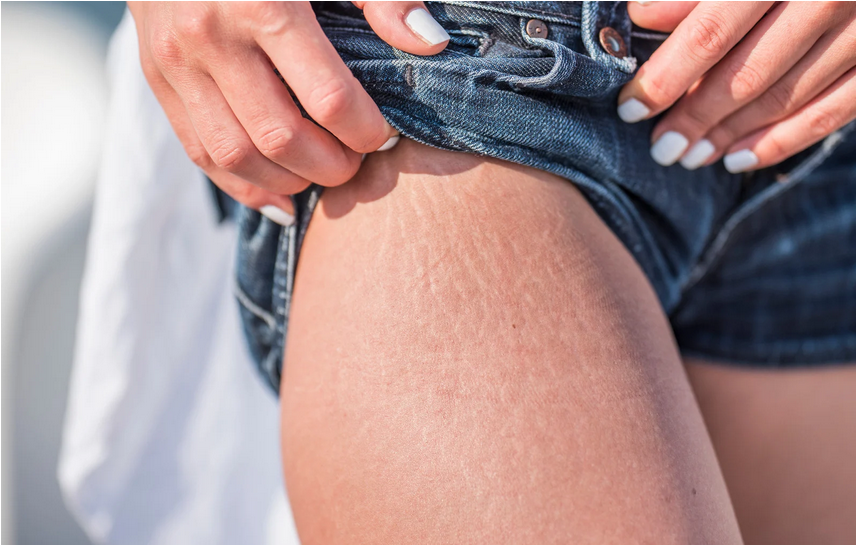
Does Scratching Cause Stretch Marks?

Have you ever felt that annoying itch and wondered if you were unknowingly sketching a roadmap of lines on your skin? We’ve all stood there, squinting at our reflection, puzzling over new or curious lines that seem to have sprung up overnight.
Hey there, we’re your friendly neighbourhood skin health aficionados with years under our belt studying the intricate details of what keeps our skin in tip-top shape. And here’s the scoop – scratching isn’t the mastermind behind those sneaky stretch marks.
Now, let’s chat about what’s truly happening under the surface: life’s roller coaster – from weight changes to the beautiful pregnancy journey – brings out these badges of experience.
That constant urge to scratch isn’t rolling out the red carpet for stretch marks; rather, they emerge as silent testimonials when our skin is stretched past its comfort zone (that’s right, even our resilient epidermis has a breaking point).
Let us tackle some folklore head-on and delve into what causes these enigmatic etchings—and maybe even find ways to give them the slip! Stick around—today’s knowledge drop could spare you sleepless nights fretting over your fabulous hide.

You’re going to want in on these truths!
Key Takeaways
What are Stretch Marks, and What Causes Them?

Stretch marks are long, narrow streaks or lines that develop on the skin and often have a different texture or colour from the surrounding skin. They can occur due to fluctuating weight, such as rapid weight gain or loss, pregnancy, and puberty.
Fluctuating weight
Our bodies change a lot. Sometimes we gain weight, and sometimes we lose it. These changes can make our skin stretch out or shrink back quickly. Think of how a rubber band looks when you pull it too hard – it might get lines on it.
That’s what happens to our skin.
Now, gaining or losing some pounds is alright. But quick changes in size can lead to those pesky stretch marks many of us know too well. They appear like little lightning bolts on the skin.
You’ll often find them where there’s been the most growth or change—like your belly after having a baby, during puberty when you shoot up in height, or even on muscles if you’ve been working out a bunch! They start as reddish lines and then fade over time but don’t usually go away completely without some help from creams or treatments.
Remember this: keeping your skin happy with lots of moisture helps big time! So, let’s slather on that lotion and keep our skin feeling good, no matter how much we weigh today or tomorrow.
Pregnancy
Pregnancy has got us all in awe of how much the body can change. Our skin stretches a lot to make room for the growing baby, which is natural. This stretching can leave us with some memorable marks—you guessed it: stretch marks.
They zigzag across our bellies and sometimes itch like crazy because the skin is getting pulled tighter than a drum.
Now, we’ve got to pamper that belly skin during these months! Keeping it soft and moisturized helps big time with the itchiness. And let’s be honest, when we feel that urge to scratch those shiny new lines appearing on our tummies, it’s no joke – but finding relief without scratching is key.
Lotions and creams become our best friends, like comfy blankets for our overstretched skin. We slather them on not just because they might help keep stretch marks at bay but also because happy skin equals less itching—and who doesn’t want that?
Puberty
Puberty is like a surprise party for our bodies – things grow and change before we even send out the invites. Our skin tries to keep up with these sudden growth spurts, but sometimes it’s like, “Whoa, buddy! Slow down!” And just like that, stretch marks may show up uninvited.
Lots of folks get them during these years. It’s not just because we’re growing fast; it’s in our genes, too. If Mom or Dad had stretch marks when they were young, there’s a good chance we’ll also see some popping up on us.
Now imagine the skin is elastic—like when we do stretching exercises—it can only stretch so much before it gets tiny tears. That’s what happens to our skin during puberty’s big growth moments.
Plus, let’s remember those special few who are on their way to becoming parents themselves! Pregnant teens might see more of those squiggly lines since their bellies are expanding at super speed to make room for the little one on board.
It all comes down to how stretchy our skin feels—or doesn’t feel—and whether it can handle all the changes without leaving a mark (literally).
Does Scratching Cause Stretch Marks?
While scratching does not directly cause stretch marks, it can worsen itchiness, redness, and swelling. Additionally, scratching can be a result of dryness and compromised skin barriers.
So resist the urge to scratch!
Scratching does not directly cause stretch marks.
Scratching doesn’t directly lead to stretch marks. Instead, it can make the itching and redness worse. Over-scratching may cause scarring, making the itchiness of stretch marks more severe.
It’s important to treat the underlying itchiness and resist the urge to scratch, as this is key to controlling itchy stretch marks.
Many factors like skin stretching, dryness, compromised skin barriers, and healing skin contribute to the itchiness of stretch marks. Does scientific evidence support that scratching or rubbing in a particular way causes pregnancy-related stretch marks?
It can worsen itchiness, redness, and swelling.
While scratching doesn’t directly lead to stretch marks, it can worsen the itching, redness, and swelling. The constant rubbing and scratching can further irritate the skin, causing more discomfort.
It’s important to resist the urge to scratch as it can exacerbate the symptoms associated with stretch marks and delay the healing process. Instead, focus on gentle care for the affected area to alleviate discomfort.
Keeping our skin hydrated and avoiding excessive rubbing or scratching can help reduce the itchiness, redness, and swelling caused by stretch marks. This approach promotes healthier skin and aids in minimizing any potential complications that could arise from excessive scratching or irritation of stretch marks.
This can be a result of dryness and compromised skin barriers
When stretch marks get itchy, the skin is often too dry, and the protective barrier is not working well. This can make the skin feel tight, uncomfortable, and more prone to irritation.
It’s like your skin’s natural defences are down, so it needs extra care and moisture to feel better.
The itching and bumpiness of stretch marks can be linked to these issues. Giving your skin some extra hydration and support could help lessen the itchiness and discomfort you are feeling.
How to Relieve Itchy Stretch Marks

To alleviate itchy stretch marks, it’s crucial to keep the skin hydrated, avoid scratching and rubbing, and use gentle, medicated creams. If you want to learn more about effectively treating and preventing stretch marks, keep reading our blog!
Keep skin hydrated
Properly moisturizing your skin can help prevent itchiness and reduce the likelihood of stretch marks. Drinking water daily keeps your skin hydrated, making it soft and elastic and reducing the chances of developing stretch marks.
Applying a hydrator and moisturizer thrice daily maintains smooth, supple, and healthy skin. This helps in reducing the itchiness associated with stretch marks as well.
Remember to drink enough water daily because staying hydrated is vital for maintaining skin elasticity and reducing the risk of developing stretch marks. It’s important to keep your skin well-moisturized by applying creams or lotions regularly to prevent itchiness and maintain healthy, resilient skin.
Avoid scratching and rubbing.
We need to be careful not to scratch or rub the stretch marks. Scratching can make the itchiness, redness, and swelling worse. And it could even lead to cuts and infections in that area.
Instead of scratching, we can gently massage the skin with oil to help ease the itchiness. We must keep our skin hydrated and avoid doing anything that might irritate it more.
So, let’s resist the urge to scratch and opt for gentle care!
Use gentle medicated creams.
Try gentle, medicated creams to soothe itchy stretch marks and support skin health. These creams can help hydrate the skin, reduce redness, and alleviate discomfort. Look for creams with aloe vera, vitamin E, or hyaluronic acid to provide soothing relief while promoting skin moisture and elasticity.
Additionally, medicated creams containing retinol may aid in reducing the appearance of stretch marks over time. When choosing products, opt for those specifically formulated for sensitive or irritated skin to ensure effectiveness without causing further irritation.
Remember that consistent use of these medicated creams is essential to see improvement in the itchiness and appearance of your stretch marks. Incorporating these products into your daily skincare routine can help manage itchiness while working towards healthier-looking skin.
Prevention and Treatment of Stretch Marks

To prevent and treat stretch marks, keeping the skin moisturized and exfoliated is essential. Avoid excessive sun exposure and consider using products like cocoa butter or vitamin E early on.
Seeking professional treatment options is also a valid choice if desired.
Moisturize and exfoliate the skin
To keep our skin healthy and smooth, it’s vital to moisturize and exfoliate regularly. Proper moisturizing helps prevent itchiness and improve the appearance of stretch marks. Drinking plenty of water daily also contributes to maintaining hydrated skin, reducing the chances of itchiness.
Maintaining a healthy weight and frequently moisturizing can help prevent stretch marks from forming.
By using gentle medicated creams, keeping our skin hydrated, and not scratching or rubbing excessively, we can effectively manage and relieve itchy stretch marks. Additionally, early use of products like cocoa butter and vitamin E can help prevent and treat existing stretch marks.
Avoid excessive sun exposure.
To keep our skin healthy and reduce the appearance of stretch marks, we should also be mindful of sun exposure. An important factor in preventing stretch marks from getting darker is using sunscreen when we are out in the sun.
This simple step can make a significant difference in maintaining the appearance of our skin and minimizing the visibility of stretch marks over time.
Preventive measures, like avoiding excessive sun exposure and using sunscreen, play a crucial role in taking care of our skin and reducing the prominence of stretch marks. By diligently protecting ourselves from excessive sunlight, we can help maintain healthier-looking skin and support efforts to minimize the impact of stretch marks on our bodies.
Early use of products like cocoa butter and vitamin E
We’ve all heard about using cocoa butter and vitamin E to prevent and treat stretch marks. However, it’s essential to know that no high-quality evidence supports their use in preventing stretch marks during pregnancy.
Despite popular belief, cocoa butter has not been proven effective in reducing the appearance of stretch marks either. While these products are often marketed as go-to solutions for stretch marks, it’s crucial to approach them with a dose of scepticism and consult healthcare professionals for more reliable treatments.
Remember that their efficacy might not live up to the hype when considering the early use of products like cocoa butter and vitamin E for managing stretch marks. It’s always best to seek advice from dermatologists when exploring options for preventing and treating stretch marks effectively because every person’s skin is different.
Seek professional treatment options if desired.
Different options are available if you want to seek professional treatment for stretch marks. You can consider laser skin resurfacing, dermabrasion, or topical treatments. It’s also important to note that it’s best to seek treatment when stretch marks are still red or purple because identifying them early is crucial.
This proactive approach can help effectively manage and reduce the appearance of stretch marks.
Now, let’s explore ways to relieve itchy stretch marks and prevent their formation.
Conclusion
Scratching doesn’t cause stretch marks. It can make them itch more. Little tears in the skin create stretch marks, not scratching. Rapid stretching of the skin causes stretch marks.
Scratching may worsen itching and redness. To relieve itchy stretch marks, keep your skin hydrated and avoid scratching. Use gentle, medicated creams to soothe the discomfort.
Moisturize and exfoliate your skin to prevent and treat stretch marks. Avoid excessive sun exposure and use products like cocoa butter early on for better results.
An expert in dermatology, Dr. Smith holds a Ph.D., has 20 years of experience, and is known for significant contributions to understanding skincare issues.
Dr Smith explains that while scratching doesn’t directly cause stretch marks, it can aggravate the symptoms, such as itching and inflammation, that come with them.
According to Dr Smith, safety and transparency are critical factors when choosing products for managing itchiness associated with stretch marks.
Dr Smith recommends keeping the skin hydrated, avoiding excessive scratching or rubbing, and using gentle medicated creams – all effective habits to incorporate into everyday life for managing itchy stretch marks effectively.
When evaluating methods for managing itchiness from stretch marks, Dr Smith emphasizes their positives but also discusses potential drawbacks compared with other available options on the market based on scientific evidence.
In conclusion, “Does Scratching Cause Stretch Marks” isn’t very effective, according to Dr. Smith’s expert opinion, due to its questionable impact on relieving itching related to this condition based on current research findings about dealing with problems related to pregnant women or pubertal individuals where tearing occurs during rapid weight changes or growth spurts which generally result in these conditions.
FAQs
1. Why do my stretch marks itch when I’m losing weight?
Well, you see, itchy stretch marks during weight loss are a thing because your skin’s getting all stretched out and adjusting when the middle layer of your skin stretches too fast; boom – hello, itchy feeling!
2. Are these red lines on my thighs more than just stretch marks?
Ah, that can be tricky! Sometimes, those red lines might look like “not stretch marks,” but could be something else entirely – like a blood blister or some other mark. If you’re unsure, it’s best to get it checked by someone who knows their stuff.
4. Does scratching make those pesky stretch marks worse?
Absolutely! Scratching might feel good for a moment, but trust me, it can irritate your skin even more and may lead to bigger problems like scarring.
5. Can anything help soothe itchy stretch marks from weight loss?
Yessiree! Moisturizing creams with shea butter and collagen are superstars at helping calm down that itchiness without making things worse.
6. What’s this bump on my stretch mark doing here?
Sometimes, when your skin gets stretched – whether you’re pregnant or hitting the gym hard – little bumps called papules can pop up on those stripes (aka “stretch marks”). They tend to hitch along with the whole stretching situation.
7. Can I stop being so prone to itching when I’ve got stretch marks?
Staying moisturized is key! Keep your skin happy and hydrated with creams that reduce stretch marks… Unfortunately, they won’t make them disappear completely.
Remember what grandma says – keep that belly buttered up if you don’t want the itchies tagging along while your body grows or shrinks!



